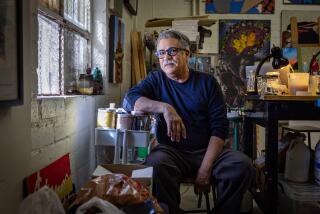Review: A painter probes hip-hop stereotypes and what it means to be black and male
Fahamu Pecou’s exhibition at Kopeikin Gallery, “Trapademia,” is inspired by trap, a genre of hip-hop that arose in the late 1990s in Atlanta.
Although lyrics sometimes celebrate drug-dealing culture, they also explore the hardships of street life, poverty and violence, particularly in the lives of black men. Pecou, who received his PhD from Emory University in Atlanta last year, creates images that subtly probe fissures in stereotypical representations of such men.
For the record:
10:10 p.m. June 17, 2019An earlier version of this article referred to the Annenberg Center for Photography. The correct name is Annenberg Space for Photography.
The seven paintings and three drawings at Kopeikin are all self-portraits. They depict the artist, dressed in colorful, stylish outfits, often posed with headdresses or masks that look like traditional African artifacts. Like the stripped-down beats of trap, the backgrounds are spare: flat and hot golds, reds and blues. The figures are isolated, like icons, pushing us to focus on the details of their poses and dress.
“Monsters and Saints” features a full-length portrait of a shirtless Pecou, facing off squarely with the viewer. He’s wearing an ornate headdress with a scrim of beads over his face, which is further obscured by large, gold sunglasses. His hands push down the waistband of his orange sweatpants, revealing at least three layers of underwear.
The pose is reminiscent of a famous photo of the late L.A. rapper Tupac (now on view across town in “Contact High,” a survey of hip-hop photography at the Annenberg Space for Photography). However, rather than bravado, something more contemplative comes through in Pecou’s image. His gaze is cast downward, and even the hands thrust into his pants feel more protective than demonstrative.
In fact, Pecou’s figures never return our gaze. They look down, or turn away, as if lost in their own thoughts or refusing to acknowledge our presence. This interiority contrasts directly with their bright, peacock attire. The man in “Jung Thug” looks dejected, sitting hunched over a bottle of liquor and empty glasses. But his shirt is covered with large, red roses, and one leg of his orange sweats is pulled up to reveal patterned socks and bright red sneakers.
Such images play, gently, with the notions of hardness and machismo that characterize stereotypes of black masculinity. Pecou’s doppelgangers mix traditional African objects with contemporary Western garb. They sport flashy clothing and display their bodies, but they also behave like reluctant models. By holding these disparate impulses in tension, the works highlight an in-between space that is quieter but richer than the typically one-dimensional images of blackness that stream across our screens.
With this work, Pecou enters into a rich dialogue with other portraitists like Kehinde Wiley and Robert Pruitt, who continue to complicate our perceptions of what it means to be black and male.
Kopeikin Gallery, 2766 S. La Cienega Blvd., L.A. Tuesday-Saturday, closes Saturday. (310) 559-0800 or kopeikingallery.com
Support coverage of the local arts scene by reading our latest news and reviews at latimes.com/arts.
More to Read
The biggest entertainment stories
Get our big stories about Hollywood, film, television, music, arts, culture and more right in your inbox as soon as they publish.
You may occasionally receive promotional content from the Los Angeles Times.






